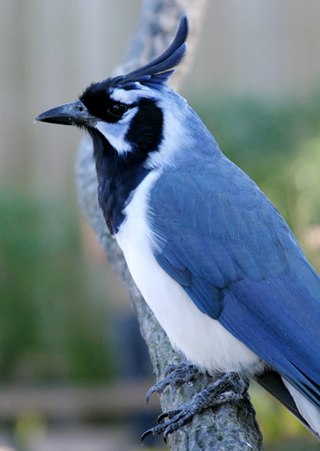
The nutcrackers (Nucifraga) are a genus of four species of passerine bird, in the family Corvidae, related to the jays and crows.

Clark's nutcracker, sometimes referred to as Clark's crow or woodpecker crow, is a passerine bird in the family Corvidae, native to the mountains of western North America. The nutcracker is an omnivore, but subsists mainly on pine nuts, burying seeds in the ground in the summer and then retrieving them in the winter by memory. The bird was described by the Lewis and Clark Expedition, with William Clark first observing it in 1805 along the banks of the Salmon River, a tributary of the Columbia River.

The pine grosbeak is a large member of the true finch family, Fringillidae. It is the only species in the genus Pinicola. It is found in coniferous woods across Alaska, the western mountains of the United States, Canada, and in subarctic Fennoscandia and across the Palearctic to Siberia. The species is a frugivore, especially in winter, favoring small fruits, such as rowans. With fruit-crop abundance varying from year to year, pine grosbeak is one of many subarctic-resident bird species that exhibit irruptive behavior. In irruption years, individuals can move long distances in search of suitable food supplies, bringing them farther south and/or downslope than is typical of years with large fruit crops.

The pine siskin is a North American bird in the finch family. It is a migratory bird with an extremely sporadic winter range.

The northern nutcracker, previously known as spotted nutcracker and Eurasian nutcracker, is a passerine bird in the crow family Corvidae. It is slightly larger than the Eurasian jay but has a much larger bill and a slimmer looking head without any crest. The feathering over its body is predominantly chocolate brown with distinct white spots and patches. The wings and upper tail are black with a greenish-blue gloss.

Pinus pumila, commonly known as the Siberian dwarf pine, dwarf Siberian pine, dwarf stone pine, Japanese stone pine, or creeping pine, is a tree in the family Pinaceae native to northeastern Asia and the Japanese isles. It shares the common name creeping pine with several other plants.

The black bulbul, also known as the Himalayan black bulbul or Asian black bulbul, is a member of the bulbul family of passerine birds. It is found primarily in the Himalayas, its range stretching from Pakistan eastward to Southeast Asia. It is the type species of the genus Hypsipetes, established by Nicholas Aylward Vigors in the early 1830s. There are a number of subspecies, mostly varying in the shade of the body plumage which ranges from grey to black, and some also occur in white-headed morphs, as also suggested by its specific epithet leucocephalus, literally "white head". The legs and bill are always rich orange-red.

Pinus gerardiana, commonly known as the chilghoza pine or neja, is a pine native to the northwestern Himalayas in Afghanistan, northern Pakistan, Waziristan and northwestern India, growing at elevations of 1,800–3,350 metres (5,910–10,990 ft). It often occurs in association with Cedrus deodara, and Pinus wallichiana.

Krüper's nuthatch is a species of bird in the nuthatch family Sittidae. It is a small to medium-sized nuthatch, measuring 12.5 centimetres (4.9 in) in length. The upperparts are blue-grey, with the front half of the crown black in adults of both sexes, but with a less marked in the female rear. The species has a black or grey eyestripe and a prominent white supercilium. The underparts are blue-grey in males and buff-grey in females, with a large, crescent-shaped rufous pectoral patch. It feeds on insects in the summer and seeds, especially pine seeds, in autumn and winter. Breeding takes place between March and May, and the nest is usually placed in a tree hole. The clutch consists of five to seven eggs, incubated by the female and fed by the male. Both parents take part in feeding the young.

The Oriental skylark, also known as the small skylark, is a species of skylark found in the Sino-Indian region and parts of central Asia. Like other skylarks, it is found in open grassland where it feeds on seeds and insects.

The Montezuma quail is a stubby, secretive New World quail of Mexico and some nearby parts of the United States. It is also known as Mearns's quail, the harlequin quail, and the fool quail.

The pale-headed rosella, is a broad-tailed parrot of the genus Platycercus native to northeastern Australia. It is a moderate-size parrot with a pale yellow head, predominantly white cheeks, scalloped black and gold back and pale blue underparts. Two subspecies are recognised, although some authorities consider it to be conspecific with the eastern rosella of southeastern Australia.

The black-throated magpie-jay is a strikingly long-tailed magpie-jay of northwestern Mexico.

The yellow-breasted greenfinch is a small passerine bird in the family Fringillidae that is native to the northern regions of the Indian subcontinent.

The black-eared fairy is a species of hummingbird in the subfamily Polytminae, the mangoes. It is found in every mainland South American country except Argentina, Chile, Paraguay, and Uruguay.

The spot-backed antbird is a species of bird in subfamily Thamnophilinae of family Thamnophilidae, the "typical antbirds". It is found in Bolivia, Brazil, Colombia, Ecuador, French Guiana, Guyana, Peru, Suriname, and Venezuela.

The rufous-bellied niltava is a species of bird in the family Muscicapidae.
Kazinag National Park is a national park in Baramulla city of the Baramulla district in the Indian union territory of Jammu and Kashmir notified under Wild Life Protection Act 1972. It is part of a proposal for a trans-Karakoram peace park with Pakistan. The area of Kazinag National Park is 160 square kilometres, and it was commissioned in 1992. The national park is located on the north bank of the Jhelum River.

The Kashmir nutcracker or large-spotted nutcracker is a passerine bird related to the northern nutcracker and southern nutcracker. Until recently, it was considered a subspecies of the former. It is found in the western Himalayas.




















